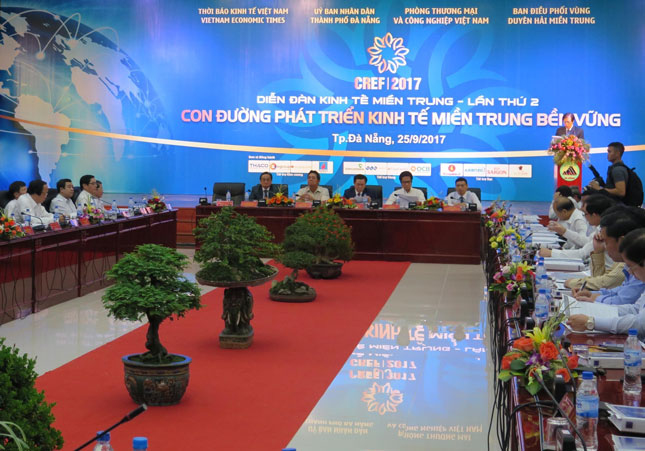Economic coordination mechanisms needed to boost central coastal region growth
The 2017 Central Coastal Economic Forum, themed ‘The Path to the Sustainable Economic Growth of the Central Region’ took place in Da Nang on Monday, under the chair of Deputy Prime Minister Vuong Dinh Hue.
 |
| The forum in progress |
The event was jointly organsied by the Da Nang People’s Committee, the Central Coast Regional Coordination Board, the Viet Nam Chamber of Commerce and Industry, and the Vietnam Economic Times.
The one-day event was attended by representatives from a total of 10 ministries and national government agencies, along with the leaders of the authorities of the 9 central coastal localities, and economic experts from both home and aboard.
Discussions focused on effective measures to remove any policy-related obstacles to make more breakthroughs in the progress of the region, and to create a harmony between each locality’s economic growth and that of the whole region.
In addition, ways to boost the operation of private businesses which plays as the driving force for ensuring the region’s sustainable economic development, were also represented.
 |
| A beautiful view of Da Nang’s Tien Sa Port |
Also at the forum, many participants pointed to the lack of coordination amongst the regional localities as a major hindrance to the economic growth of the whole region.
Professor Dao Nguyen Cat, the Editor-in-chief of the Vietnam Economic Times, said that there have been many discussions on how to shore up the central region’s economy but to date the conflict of interest between the localities has yet to be resolved, and the regional links have yet to be promoted effectively.
Chairman of Thua Thien-Hue Province Nguyen Van Cao stated that one of the main reasons for the inefficient regional connection is the similarity in the economic structure between the localities. Meanwhile, no connections are planned to share the same advantages of the infrastructure investment in the central coastal localities. He added many localities have the the same economic spearhead aspects and products, but they all face a shortage of support industries and services. For example, Thua Thien-Hue Province has already developed the Chan May-Lang Co deep-sea port, but neighbouring Da Nang also plans to build its own Lien Chieu Port as a key logistics centre just 20km away.
The Head of the central region’s Development Consultancy Council, Mr Tran Du Lich, highlighted the importance of establishing a dedicated marine economic axis, with the priority given to building a coastal route running through the regional localities, thereby creating closer links amongst them.
In his speech at the event, Deputy Prime Minister Hue remarked that the central region play the most significant role in boosting the development the Viet Nam’s marine economy. Located on the North-South traffic axis, the region is in close connection with the central highlands, and Laotian southern and Cambodian northeast regions, plus the Greater Mekong Sub-region. Moreover, the region boasts the great potential for natural resources and abundant labour forces.
The Politburo has requested that budget collection and spending should be decided on a regional basis first, before taking each locality into account. This is considered as a key change in the mind-set on boosting regional economic development.
He also asked domestic and foreign economic experts, and the leaders of the central coastal localities to give more suggestions to the national government to perfect the country’s regional coordination mechanisms and economic coordination institutions for economic zones nationwide.
Last, but not least, Deputy Prime Minister Hue underscored the need to continue identifying the potential and advantages of the region, as well as opportunities and challenges facing it in the current context of deep international integration and the strong development of the Fourth Industrial Revolution, or Industry 4.0.



